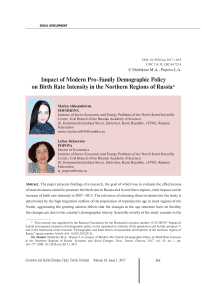Impact of modern pro-family demographic policy on birth rate intensity in the northern regions of Russia
Автор: Shishkina Mariya Aleksandrovna, Popova Larisa Alekseevna
Журнал: Economic and Social Changes: Facts, Trends, Forecast @volnc-esc-en
Рубрика: Social development
Статья в выпуске: 1 (49) т.10, 2017 года.
Бесплатный доступ
The paper presents findings of a research, the goal of which was to evaluate the effectiveness of state measures aimed to promote the birth rate in Russia and its northern regions, their impact on the increase of birth rate intensity in 2007-2015. The relevance of choosing these territories for the study is determined by the high migration outflow of the population of reproductive age in most regions of the North, aggravating the growing adverse effects that the changes in the age structure have on fertility, the changes are due to the country's demographic history. Scientific novelty of the study consists in the fact that it determines the total demographic effect of current measures of pro-family policy, evaluates the results of enhancing its activities and makes a contribution to scientific studies on identifying the impact of the behavioral component of fertility on the formation of the final number of children in the family in terms of government incentives provided to families...
Birth rate intensity, demographic policy, factors promoting birth rate, age structure, reproductive behavior, northern regions of Russia
Короткий адрес: https://sciup.org/147223904
IDR: 147223904 | DOI: 10.15838/esc.2017.1.49.92894375510.15838/esc.2017.1.49.10
Список литературы Impact of modern pro-family demographic policy on birth rate intensity in the northern regions of Russia
- Arkhangel'skii V.N. Faktory rozhdaemosti v Rossii . Demograficheskie perspektivy Rossii . Ed. by G.V. Osipov and S.V. Ryazantsev. Moscow: Ekon-Inform, 2008. Pp. 253-265..
- Zvereva N.V., Arkhangel'skii V.N. Predvaritel'nye itogi i perspektivy sovremennoi politiki v oblasti rozhdaemosti . Federalizm , 2010, no. 2 (58), pp. 69-84..
- Ivanova E.I. Rozhdaemost' v sovremennoi Rossii: ozhidaemyi pod"em ili kon"yunkturnyi sdvig? . Nauchnye trudy: Institut narodnokhozyaistvennogo prognozirovaniya RAN , 2010, no. 8, pp. 610-626.
- Kalachikova O.N., Shabunova A.A. Vozmozhnosti i rezervy povysheniya rozhdaemosti v Rossii . Problemy razvitiya territorii , 2013, no. 6 (68), pp. 66-72..
- Kuchmaeva O.V. Vozmozhnosti statistiki v otsenke effektivnosti sotsial'nykh proektov . Statistika i ekonomika , 2010, no. 5, pp. 96-103..
- Perevedentsev V.I. Demograficheskie perspektivy Rossii . Sotsiologicheskie issledovaniya , 2007, no. 12, pp. 58-69..
- Popova L.A. Demograficheskoe razvitie sem'i v Respublike Komi . Syktyvkar, 1998. 26 p..
- Popova L.A., Butrim N.A. Sovremennye standarty reproduktivnogo povedeniya naseleniya i zadachi prosemeinoi demograficheskoi politiki . Ekonomicheskie i sotsial'nye peremeny: fakty, tendentsii, prognoz , 2011, no. 2 (14), pp. 72-85..
- Rimashevskaya N.M., Bochkareva V.K., Migranova L.A., Molchanova E.V., Toksanbaeva M.S. Chelovecheskii potentsial rossiiskikh regionov. Demograficheskaya sostavlyayushchaya chelovecheskogo potentsiala . Narodonaselenie , 2013, no. 3, pp. 82-141..
- Favstritskaya O.S. Formirovanie investitsionnogo mekhanizma zhilishchnykh rynkov v usloviyakh depressivnykh severnykh regionov (na primere Magadanskoi oblasti): dis. … kand. ekon. nauk . Moscow, 2017. 167 p..
- Fauzer V.V. Demograficheskie problemy severnykh regionov Rossii: sokrashchenie chislennosti naseleniya i snizhenie rozhdaemosti . Korporativnoe upravlenie i innovatsionnoe razvitie ekonomiki Severa: Vestnik NITs KPUVI SyktGU , 2015, no. 1, pp. 129-144..
- Freika T., Zakharov S.V. Evolyutsiya rozhdaemosti v Rossii za polveka: optika uslovnykh i real'nykh pokolenii . Demograficheskoe obozrenie , 2014, no. 1, vol. 1, pp. 106-143..
- Shabunova A.A., Kalachikova O.N. K otsenke effektivnosti stimulirovaniya rozhdaemosti (na materialakh Vologodskoi oblasti) . Demograficheskie protsessy na postsovetskom prostranstve: materialy VI Ural'skogo demograficheskogo foruma s mezhdunarodnym uchastiem . Executive editors A.I. Tatarkin and A.I. Kuz'min. Yekaterinburg: Institut ekonomiki UrO RAN, 2015. Pp. 377-384..
- D'Addio A., D'Ercole M. Trends and determinants of fertility rates in OECD countries: the role of policies. OECD Social, Employment and Migration Working Papers. No. 27. Paris: OECD. P. 47.
- Grant J. et al. Low fertility and population ageing: causes, consequences and policy options. Santa Monica: RAND, XV, 2004.
- Kravdal O. Demographer's interest in fertility trends and determinants in developed countries: Is it warranted? Demographic Research, 2010, vol. 22, art. 22, pp. 663-690. Available at: http://www.demographic-research.org/Volumes/Vol22/22/
- Lutz W. Will Europe be short of children? Family Observer, European Observatory on Family Matters, European Commission. 1999. Pp. 8-16.
- McDonald P. Low fertility and state: efficiency of policies. Population and Development Review, 2006, September, no. 32 (3), pp. 485-510.
- Milligan K. Quebec's baby bonus: can public policy raise fertility? Backgrounder, C.D. Howe Institute, January, 2002.
- Neyer G. Family policies and low fertility in Western Europe. MPIDR Working Paper. Rostock: Max Planck Institute for Demographic Research. July, 2003.
- Testa M.R., Basten S. Certainty of meeting fertility intensions declines in Europe during the "Great Recession". Demographic Research, 2014, vol. 31, art. 23, pp. 687-734. Available at: http://www.demographic-research.org/Volumes/Vol31/23/


